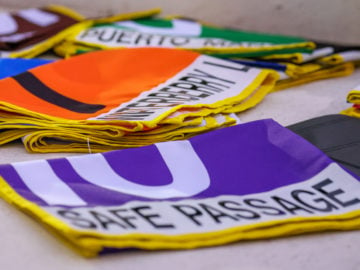DECEMBER 1-7
The course manager at Newmarket is warned off after an inquiry by the Jockey Club into tampering with the going at Newmarket a fortnight ago.
TBA General Manager John Kramer and Kimberley breeder Basil Benjamin return home after vetting all of the entries for the 1992 yearling sales around the country. They have seen almost all of the classic winners for 1994 – if only they knew where!
M-Net starts it new Parade Ring feature programme, broadcast every Saturday at twenty to seven in the morning.
In the East-Cape, Jockey Club Local Executive chairman Morum stresses a need for greater realism in racing, and urges racing authorities around the country to re-assess the cost of maintaining their under-utilized assets. Morum’s personal bombshell is to develop one of the two race courses in PE (Arlington) as a township, and retain just one track for racing and training in the East Cape (Fairview).
South African stallion Lancaster shows he can throw the bomb when his daughter Ilifa wins the Cape Fillies Guineas Futurity. Easy to back at 8/1, Ilifa improves somewhat on her useful juvenile form. Favourite Magnificent Miss refuses to settle and runs way below best, while second favourite Perfect Order breaks a bloodvessel and finishes last.
The timing equipment at Milnerton fails for the umpteenth time, but this time it’s in a big race. Even so, few people take notice and one is tempted to ask why the club bothers to time at all.
For those who recognise the importance of pace and time, the good old handheld stopwatch shows a rather sedate 25:0, 37:0, 49:0, 61:0 and 1:38:0 for the Fillies Guineas.
Transvaal trainer Ferraris makes it three-in-a-row in the Alan Snijman Stakes, when Rakeen wins the 1991 running of that feature race. The son of Northern Dancer sports blinkers for the first time. “He’s a difficult horse to train”, says Ferraris, “and the blinkers make him concentrate better. He’ll continue to wear them from now on”.
Rakeen’s next mission should be the J&B Met, provided he draws well.
At Greyville Lester Piggott draws an enthusiastic but small crowd when he returns to South Africa for the first time in ten years. The occasion is the M-Net AllStars jockey competition, shown live on the pay-net. Piggott competes in the four-race challenge with Michael Roberts, Mauritian champion jockey Anand Bundhoo (still an apprentice) and eight leading SA jockeys, including Lloyd, Strydom and Van Wyk. Felix Coetzee is a notable absentee.
Lester fails to win a race. Rhys Van Wyk collects the R20.000 winner-takes-all prize, with Roberts in second place, and Lloyd third.
A Pick Six carry-over earlier in the week made the Greyville pool swell to R1.3 million. Seventy winners collect R14.000 each.
DECEMBER 8 – 14
Piet Theron, General Manager of Topsport, reacts in the Sunday Times to an article written by Dave Mollet the week before (“Racing left off SABC screens as M-Net runs clear of the TV field”), which related to M-Net rather than SABC showing of the First National day’s feature races.
Theron’s comments on Mollet’s article clearly show that the SABC and Topsport after all these years still do not have the slightest idea what makes racing people tick.
And Theron’s closing statement that Topsport is committed to support and promote racing in its broader context can safely be relegated to the “hot air” division.
Theron also states that had First National decided to stay with Topsport rather than defect to M-Net, it would have received far higher viewership on Topsport. Not even a week later Topsport shows the White Horse Invitation Stakes on TV1, but relegates the White Horse Dingaans (run half an hour later) to TV2/4, as TV1 by then concentrates on an extended period of golf. A clever ruse perhaps to claim extended viewership for the combined White Horse broadcasts, and presumably an ecstatic sponsor, but “support and promote racing in its broader contest”? Who’s kidding who, Piet?
Miss Averof wins the White Horse Invitation Stakes for the second year running. The first three past the post do so in the same order as the year before.
The White Horse Dingaans falls to the Spies-trained Petros, who beats Fluent Stride and stable companion Fast Gun. Spies had publicly stated on many occasions that Petros is superior in his home gallops to Fast Gun. Even so the latter had started favourite for the Dingaans, while Petros (drawn wide) started an easy to back 8/1.
While technicians fumble to find the relevant video insert for the evening news, SABC newsreaders repeatedly refer to the White Horse Invitation Stakes as the “White Horse Derby”.
Now that should have some people jump.
Jockeys, trainers and bookmakers in the Western Cape must have been tossing in their sleep, when reports surface of a secret inquiry into race fixing. In the face of wild rumours Cape stipes confirm that there is an inquiry, reveal that it relates to an incident that took place about a year ago, and state that the stipendary board had listened to four or five hours of evidence.
As yet no charges have been laid.
SAROA gets mixed up in the go-slow action advocated by certain elements in the Transvaal trainer’s ranks. The TTA (Transvaal Trainers Association) appears to attempt to blackmail the owners into supporting trainer’s medical aid, pensions, appearance money and an increased portion of stake money.
SAROA (SA Racehorse Owners Association) chairman Swersky tells the trainers in a carefully worded statement where to get off – and rightly so.
DECEMBER 15 – 21
South African top riders make a trip to ride in Zimbabwe. Felix Coetzee, Piere Strydom and Doug Whyte don silks at Borrowdale Park, which stages Sunday racing for the first time. Each of the trio wins one race on the nine-race card at the track.
Racing in Zimbabwe is set to celebrate its centenary next year.
Also in Zimbabwe, a company that accepts bets on SA racing opens to punters in Harare. The company, National Pools, has four branches and hopes to have 30 off-course venues by next year. At present only bets on South African racing are accepted. The company is still negotiating to bet on the local Zimbabwean product!
Scottsville races on December 16th – the Day of the Vow, after the Provincial Ordinance is hurriedly amended earlier. Officially there is no inter-provincial betting in the Cape and Transvaal on the Scottsville meeting, as Provincial Ordinances there do not allow totes and bookmakers to operate on the day.
The meeting is a success, and Natal raceclubs now set their sights on Sunday racing.
In the UK, the Jockey Club finally bows to pressure for reform by announcing that it will cede responsibility for the running of racing to a new British Horseracing Board. The Jockey Club will have four seats on the 10-seat executive of the new board.
The Breeders Cup, held in the US in November, offer American racing fans a unique and innovative wagering product: the Breeders Cup National Pick Seven. This bet allows fans throughout the country to bet into a national common pool. While pay-offs are determined on a merged pool basis, each jurisdiction that allowed the wager was able to maintain its local takeout rate because of a unique net pool pricing method used in the calculation of the final pay-out.
Figures released after the Breeders Cup meeting put betting in the US in perspective, and South Africans will look in amazement at how small the figures are. The Pick Seven was available at over 500 outlets spread throughout 29 States. A total of $8.5 million was wagered, of which $2 million came from Churchill Downs and $1.6 million from Santa Anita.
Not a single person managed to pick all seven winners, and the 29 tickets that has six winners on the day paid $225.000 each.
Although the new bet is regarded as a success by US officials, suggestions for 1992 include a guaranteed pool of $10 million to stimulate interest, and the introduction of a “machine pick”, where a punter can allow the computer to randomly pick the horses in the races – this to open up the wager to a new segment of the betting market.
The US Thoroughbred Racing Association’s “1995 Committee” (charged with the responsibility of how and where US racing should be going) is now looking the introduction of a weekly nationwide Pick Six, utilizing races from throughout the country and televised on a national show.
Now in which South African magazine did we read just that suggestion a few years ago?
At Newmarket, Tobie Spies wins the trainers competition held at the track during November and December. Spies finishes ahead of Jean Heming and Ormond Ferraris, while Michael Azzie and Tony Millard tie for third. The winner collects the first prize of R25.000.
Chris Smith Bloodstock holds a second Ready-to-Run sale. The venue is the parade-ring at Kenilworth, where the youngsters are galloped before going through the ring. The sale averages R18.600, with 26 lots sold.
The Natal TAB introduces TAB-Form, a broadsheet to replace racecards from “other” centres usually sold in Natal Tote outlets. The sale of those “other” racecards is claimed to be an expensive administrative burden on the Natal TBA.
The new TAB-Form incites fury from the East Cape racing executive, who claim copyright in PE-fields lies with Computaform (the PE Computaform is the official PE-racecard). Computaform’s lawyers aren’t slow to send ultimatums to the Natal TAB, which do little to calm the tempers. In the end Computaform (which is part of the free-market-loving Times Media empire) settles the issue quietly.
This episode once again puts the spotlight on the assumed copyright of racing information, which has never satisfactorily been proven to lie with those who claim to own it. In PE especially the copyright issue has now taken on alarming proportions, and one can only suspect that for the East Cape clubs more is at stake than just copyright.
The draw for the J&B Met takes place. Sixty-two horses are weighted for the event, but only twenty will be able to run. Most of the fancied runners draw well, except for Miss Averof, who ends up in the dam at 61. First acceptances are on 6 January.
Delta Force, who walks around like a cripple in the saddling-up enclosure at Kenilworth, wins the Gr2 Merchants at the track some ten minutes later. Easy to back at 12/1, he storms up in the dying strides to snatch victory from three-year-old Signor Amigo (8/1), with Rock Candy (5/1) in third.
DECEMBER 22 – 28
In Japan, owners of video game systems are now able to bet on horse racing. An initial group of 8500 households with Nintendo (or three other video game systems) has their systems connected to the computer of the Central Racing Association in Tokyo. The Association is the clearing agent for legal racing bets.
The betting-at-home set-up is similar to that used for home shopping or stock trading. A special video game cartridge and a modum allows people to communicate with racing’s computer system, and the TV screen is turned into a tote board with the latest odds. Punters in Japan will be charged about R15 a month for betting through the new system.
Odds-on favourite Flaming Rock, racing on imported Dutch shoes, is never sighted in the Gr1 Queens Plate. The race is run at a crawl, with the first 1000m of the Plate going 2 seconds slower than the first 1000m of a B-division 2000m handicap race run half an hour later. The Gr1 event becomes a sprint up the straight, won by the Darryl Hodgson trained I’m Taking It, who becomes the second feature winner in a week for his trainer. Unlucky horse of the race may have been Miss Averof, who is switched five horses wide in the last 200m to find a way through, and loses by a diminishing length. Of the other J&B Met hopefuls Pas de Quoi disgraces himself by finishing near last (he is reported to be suffering from a virus), but Spanish Galliard gets a satisfactory second. Senor Santa, despite the slow early pace, fails to run on from the 200m. Flaming Rock’s failure is blamed on his increasingly coltish behaviour. Trainer Snaith gives notice of intention to race Flaming Rock with blinkers in the J&B Met, and without the special Dutch shoes.
On the Rand, the Argentinian gelding Ilustrador makes his return to the track after lay-off of a year and a half. He runs right to his former best form, when beaten a short-head by Special Squad, who receives eight kilos. Race-favourite Rakeen is a well beaten third, but the nine-furlong race is said to have been too short for the imported son of Northern Dancer.
On the same day Empress Club demolishes the opposition in a middle division handicap over 1400, and plans to take on the colts in the Gr1 Cape Guineas in February are becoming firmer.
DECEMBER 29 – JANUARY 4
Jockey Shea is suspended for two weeks for his riding of juvenile first-timer Noble Fighter in an “incompetent and unprofessional” manner. Noble Fighter started at 7/1, was some nine lengths in arrears at the 400m mark, and made up seven lengths in the last 200m to finish a close second.
In the Transvaal, stakes are increased by about five percent. The increase is less than what was hoped for. The Highveld Racing Authority states it will review the province’s stakes again in the middle of 1992.
In Bloemfontein Pagan Lord is scratched by mistake (officials blame the trainer, and vice versa) and announced as a non-runner in betting offices around the country. The trainer shows little concern for the betting public, however, and gets a court order to re-instate his runner. The court order is signed by a judge who clearly understands nothing about racing and consequently was in no position to administer justice.
The re-instatement is only passed to the betting offices within minutes of the start of the race. Pagan Lord runs fourth, infuriating punters in the Cape who lose their Quartet-bets en masse – there are, predictably, no winners.
The Podlas racing empire acquires a new trainer when Noel Scholefield makes way for former Cape trainer Michael Schuleman.
Transvaal trainer and owner Dean Maroun has a winner in the second race at Gosforth Park, then proceeds to become the sole ticket holder in the day’s Pick Six. Maroun collects R1.2 million.













